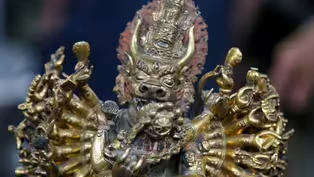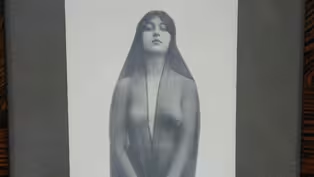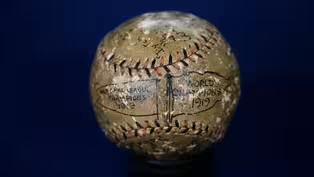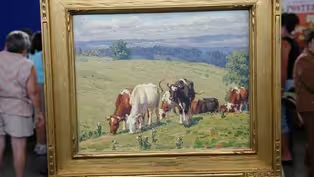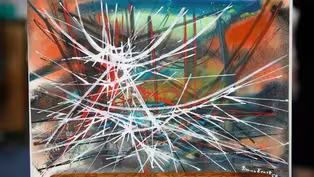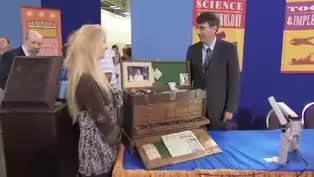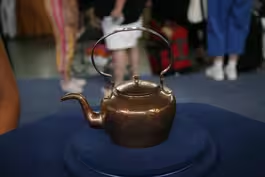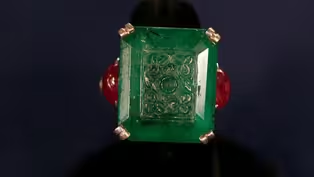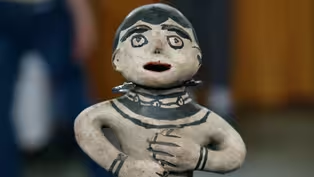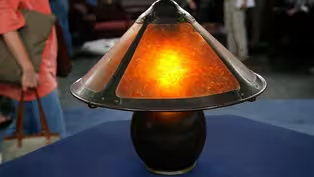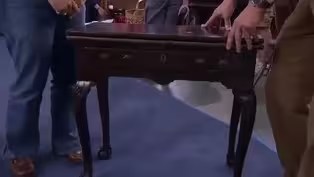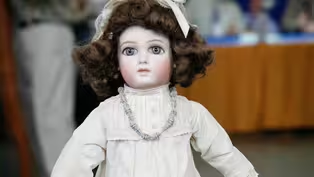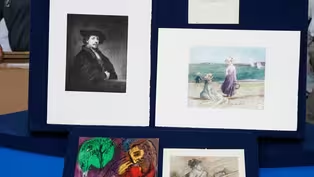
Vintage Louisville 2021, Hour 1
Season 25 Episode 10 | 52m 31sVideo has Closed Captions
Giddy-up to Derby City for updated Season 12 appraisals, including one that’s $150K-$200K!
Giddy-up to Derby City for updated Season 12 appraisals including a Dirk Van Erp lamp from around 1910, a J. Falter "Listening to the Sea" illustration, and a 1919 Cincinnati Reds championship baseball. One is now valued at $150,000-$200,000!
Problems playing video? | Closed Captioning Feedback
Problems playing video? | Closed Captioning Feedback
Funding for ANTIQUES ROADSHOW is provided by Ancestry and American Cruise Lines. Additional funding is provided by public television viewers.

Vintage Louisville 2021, Hour 1
Season 25 Episode 10 | 52m 31sVideo has Closed Captions
Giddy-up to Derby City for updated Season 12 appraisals including a Dirk Van Erp lamp from around 1910, a J. Falter "Listening to the Sea" illustration, and a 1919 Cincinnati Reds championship baseball. One is now valued at $150,000-$200,000!
Problems playing video? | Closed Captioning Feedback
How to Watch Antiques Roadshow
Antiques Roadshow is available to stream on pbs.org and the free PBS App, available on iPhone, Apple TV, Android TV, Android smartphones, Amazon Fire TV, Amazon Fire Tablet, Roku, Samsung Smart TV, and Vizio.
Buy Now
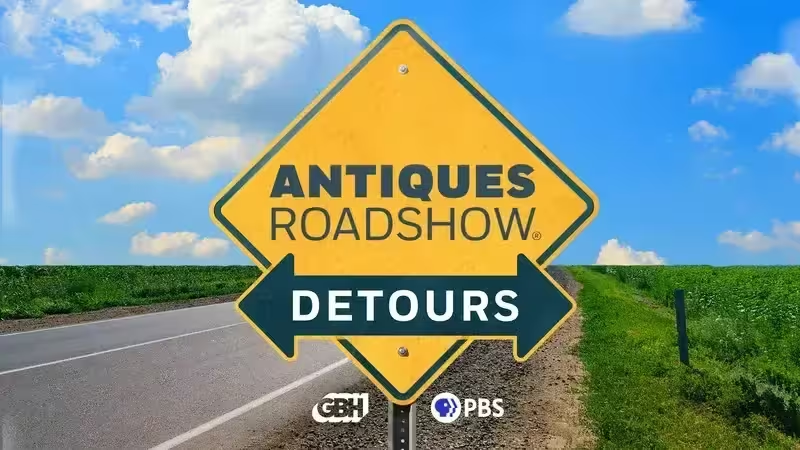
ANTIQUES ROADSHOW DETOURS
Ever wondered what happens to the treasures featured on America’s beloved ANTIQUES ROADSHOW after the cameras leave town? Host Adam Monahan tracks down the juicy afterlives of your favorite finds from PBS’s hit series.Providing Support for PBS.org
Learn Moreabout PBS online sponsorship♪ ♪ I love this group of prints because it illustrates to me, as an auction guy, the pleasures, but also the pitfalls, of buying at auction.
(whimpers) Oh, my!
(laughs) I'm surprised.
Whoo!
♪ ♪ CORAL PEÑA: In 2008, "Roadshow" visited Louisville, home of the Kentucky Derby, where our experts checked out the prize possessions of the crowded field.
APPRAISER: This is by far the best baseball I've ever seen on the Roadshow.
PEÑA: Have the value of these treasures kept up or fallen to the back of the pack?
Let's find out in "Vintage Louisville: Hour 1."
MAN: I have a friend who had birds in her attic, and she asked me to help her clean it out.
She told me to throw everything out.
And I decided that I'd go and ask her and make sure, because I saw some things up there.
And she said, "No, it's all trash; throw it out."
And so I kept this and a few other pieces.
APPRAISER: Was there any reason why you kept this one, or...?
Not really.
I just kind of liked it.
It was kind of different and...
It looked old, but I couldn't tell if it was old or not, so I wasn't sure.
Do you know if she bought this?
No, I don't think she bought it.
I think that there were things that had been up there for a while, 'cause there was old newspaper articles in there with it, too, from, early, early newspaper articles, so...
It's from New Mexico, and it's from a pueblo village near Santa Fe called Cochiti.
And these figures were made strictly to sell to the tourists, and they started making them pretty early.
This one was probably made 1890, 1900, right in there.
It's hard to come up with an exact date.
What's neat about this is, it's a full-size figure, the design on it's great, the birds on the front.
And what I really like is the back.
It's got this full pattern that goes all over it, and really has a nice design.
The bad part is, the foot's broken.
These have gotten real collectible, even though they're, like, tourist things.
I mean, the, the Cochiti people stood beside the railroad track at the train station and sold these things for, like, a quarter.
If this was to come up for sale at a gallery in Santa Fe, it would bring somewhere, $3,000 to $5,000.
(chuckling): You're kidding, right?
No, I'm not kidding.
And there are some bigger ones, but this is a great one.
And, I mean, I'm even talking with the broken foot, it's worth that.
Wow.
It was a hot, sweaty day up there; I'm glad I did it now.
Yeah.
Paid off in the end, huh?
It did.
Thank you.
I appreciate it.
I bought it at an auction here in Louisville.
Okay.
About three-- two or three years ago.
Two or three years ago.
And, uh, now, what drew you to this piece?
Well, I grew up in Connecticut.
Okay.
And we had a piece like this in my family, but another sibling got it.
Ah.
And I always wanted to have a highboy.
Sister?
Brother?
Sister.
Your sister got it.
So I decided that I would love to have one of my own, and I saw this at an auction and just... And it came up at auction and you bid on it.
Yes.
Well, I assume it's made in Connecticut.
Okay.
And there is a label on the back that has a Connecticut antique dealer's name on it.
Okay.
This is definitely a Connecticut piece.
And it's, it's pretty exciting, because we don't see a lot of Connecticut furniture like this from the colonial period in this condition.
It's made about 1765-1770, so pre-Revolutionary War.
And this has these pad feet, which are typical New England, and you see them in other areas.
But combined with this angular knee and this beautiful shaped skirt, that beautiful rhythm that continues around the side.
This is so great, it's this great cyma cut in the sides.
And as you go up the case, these graduated drawers of this highboy, and then you have these wonderful pinwheels, with the center roundel, and, of course, the fan, which, which, they complement each other really nicely.
Don't you think?
Yes.
We don't know the exact maker, but it probably was made in the New London County area.
Now, one of the big questions about these highboys like this, or high chest of drawers, is that, because this comes apart from the bottom, sometimes they're married or associated.
Yes.
And on this one, what we're going to do, I'm going to pull out a drawer here, from the lower section, one from the top... And the great thing is, we know this one's not married.
Ah!
Wonderful!
It's not married.
And, and if you look here, these dovetails, see how they perfectly match?
Yes, they do.
And these are the same width of the drawer sides, same chunk of wood, same matching dovetails, same thickness.
And I love this about this.
Look at that right there-- there's a drawn horse in graphite, do you see that?
Maybe done by a child.
And the great thing about this, the lower section has this oxidized white pine secondary, typical of Connecticut, and that, right there, is the oxidized color on the underside.
This is from the bottom.
Ah!
The top never got any air.
Of course.
It's enclosed, so it didn't get brown.
So that's a nice sign of the authenticity.
So we know these were always together from that, but the great thing is, on the back, the label is a wonderful label.
And it's antique shop label from New London, Connecticut, and on there is a three-digit phone number, so it's probably from the 1920s, '30s, or earlier.
And it mentions "colonial relics" that they deal in.
So this is certainly a colonial relic that's really survived.
Good!
It's a nice finish; it's cherrywood.
It's not original finish.
But it's probably maybe... Maybe 80 or 100 years old.
These are imported probably Birmingham brasses.
And there's this foliate leafage typical of the period-- you know, 1765-- but these are really over the top.
Really made-- they would've been very expensive back in that period.
If you look right here, you're missing the escutcheon plates.
I wondered, yes.
I highly recommend that you have those replaced.
You can have these recast and put on the escutcheon plates.
So it would really help the design of it.
Ah!
And what did you pay for this piece?
Uh, $7,000.
$7,000, okay.
We would put an auction estimate on this highboy of about $12,000 to $18,000-- possibly $15,000 to $20,000.
I love it.
(chuckles) APPRAISER: It's a lovely peacock brooch.
And it's set with some different kind of stones.
Instead of round diamonds and emeralds and rubies and sapphires, we have something called rose cuts.
They resemble a rosebud.
So it's very sort of asymmetrical facets on all of these stones, which is very unusual.
I would date it to about circa 1930, 1920s, right around that time period.
APPRAISER: The basic shape and this type of decoration and, importantly, the mark on the bottom tell us that this is Chinese.
This mark is not a reign mark.
It actually talks about a company in Hunan province that manufactured this jar.
This is a fine-quality example of what was made at the time, and it's extremely rare.
My husband and I got married ten years ago.
And we started collecting antiques before we got married.
And when we did get married, my grandparents wanted to do something special and different.
So my grandfather's sister's husband's father was a huge collector.
My grandma went through his collection and picked this out for us.
The Roseville Company, which was in Zanesville, Ohio, went through many different lines.
This one you mentioned as being Fudji.
Almost.
The gentleman who designed this line, his name was Gazo Fudji, and he came from Japan.
He designed several lines there.
This beautiful one, which is referred to as Fujiyama.
Okay.
Fujiyama is a little bit earlier than Fudji.
Oh, okay.
Maybe by a year-- 1905.
Okay.
And then Fudji came after, in 1906.
Okay.
Now, they're very similar.
They're both very stylized.
Yeah.
Done in the Arts and Crafts movement.
Fujiyama is better than Fudji by about $1,000.
So if this were Fudji, it would be about $1,500 to $2,000.
But because it's earlier Fujiyama, with this rare background glaze, we're talking $2,500 to $3,500.
And, if you're putting an insurance value on that, I'd put $4,000.
Okay.
This is a sweet little pot you have here.
And for all the Fudjis that one will see, maybe out of ten or 20 Fudjis, you'll see one Fujiyama.
WOMAN: My husband and I actually went to an auction here in Louisville.
Right.
And walked through and saw the prints that we liked and I left the bidding up to him, and he came home with these.
So you bought them all at one auction?
Yes.
And what did you pay for them?
Between $500 to $1,000 for each one.
I think this was the least expensive and that was the most expensive.
And are you guys art collectors?
Have you been collecting art for a while, or is this a... Nope, this is our whole collection.
I love this group of prints because it illustrates to me, as an auction guy, the pleasures, but also the pitfalls, of buying at auction.
(whimpers) (laughs) Now, you did well, let me tell you that.
Let me start over here.
This is a reproduction of a Rembrandt painting.
It's a self-portrait of Rembrandt.
And it's something that's done in the last 50 years.
Okay.
Doesn't have a whole lot of value.
Okay.
This is actually an original print.
It's a color lithograph by Marc Chagall.
Yet it's from a large edition, printed for a book, and, therefore, it doesn't have a lot of value, either.
This is actually a reproduction of a pastel drawing by Degas.
So, as a reproduction, it doesn't have a whole lot of value.
Okay.
It's pretty, but not valuable.
This beach scene is a reproduction of a painting by Renoir.
So, again, pretty, not terribly valuable.
Okay.
Now, the smallest one up here, which looks maybe the least impressive...
Right.
...is actually an original etching by Renoir.
Okay.
And it's a subject that he worked on in at least four different versions in print.
It's the "Chapeau Épinglé," or "The Pinning of the Hat."
And this is the first etched version of the "Chapeau Épinglé" that Renoir did.
He made this print in the 1890s.
And it's something that is not as common as the later versions.
Oh, okay.
Where he developed the theme more carefully, and as such, it's a little more scarce and has more value.
Overall, you were saying you spent about $2,500 for the whole group, right?
Mm-hmm.
And when was this?
Oh, not too long ago-- couple of years.
Now, reproductions like these-- the Rembrandt, the Degas, and the Renoir-- they're just decorative; you know, maybe $50, $100 apiece, so...
Okay.
There you can see, you definitely overspent on those.
Right, okay.
The Chagall, it's more in line with what you should be paying at auction.
That's probably in the neighborhood of about $500 to $700 at auction.
Okay.
And the good news, which I've been saving for last, is this little guy here.
And, at auction, $4,000 to $6,000.
Towards the high side for that.
Wow!
So, $4,000 to $6,000.
Adding all that up, with that one print, you did well.
Good.
And I love that you went out and did this.
You know, you went to auction; it's a gutsy thing to do if you're not in the field.
Yeah.
And you, basically, you bought with your eye, and that's, you know, that's just what you should do.
But I think it also shows you that it's terribly important to know what you're buying, too.
Yes.
Like anywhere else, knowledge is power.
Right.
And that's so true at auctions, so... Is there any way to, to know, when we're looking at things, reproductions versus... A good way to tell a reproduction-- it's a general thing, and you can't always tell a reproduction this way-- is to hold a magnifying glass to it.
Okay.
And if you see a uniform pattern of dots, that is indicative of a reproduction.
Okay.
MAN: It was given to me by a woman in her early 90s.
And it was given to her by another woman that originally owned the doll.
She was going into a nursing home, and she asked me if I knew a little girl that would like to have a doll, and I said, "Yes, "I've got a daughter that's about four years old," and so she gave it to me.
And I've been trying to find out things about it, and I've looked on the computer and I've looked at books before that.
I really don't know anything about it.
Would you guess how old she is?
I had a lady that told me that it was probably in the late 1800s.
It was made, actually, around 1876.
Any idea who made it?
I've been told it could be a Bru or it could be a Jumeau, I don't know.
Unfortunately, there's no marks on it at all.
There's no mark on the head, there's no mark on the body.
But that's a good thing.
It's actually a Jumeau.
It is?
It's what they call a Portrait Jumeau with extreme eyes, these wraparound blue paperweight eyes.
An early eight-ball-joint body.
The clothing was made for her in the period 1876-1878.
The only thing that's not original with her is her hair.
But if you do this, you find there's her original wig, which is made out of sheepskin.
Right.
Which you can see is worn.
And it would've been a little frizzier, like, sticking out a little bit more.
But you really wouldn't do anything to it.
Just leave it alone.
So, luckily, that's retained.
This you don't need to use.
Okay.
So very good condition.
Beautiful eyes.
Very fine-quality bisque.
I guess you want to know what she's worth.
I would like to know that very much.
At a very good doll shop, expect to pay retail between $12,000 and $15,000 for her.
Really?
Yeah, really.
(laughs) So now you know who she is.
And she looks much better with that new wig off her head.
So leave the wig off.
Leave the wig off.
I had no idea, really, I had no idea.
Uh-huh.
But, I mean, that really throws me.
APPRAISER: I'm all for artists doing their homework and preparing for their paintings, but Edward Volkert, who, in fact, became known as America's cattle painter... Oh!
...went so far as to visit slaughterhouses.
Didn't know that.
To make sure that he was getting cow anatomy right.
Huh.
And I think he did here.
What can you tell me about the painting?
I inherited the painting from my great-uncle.
He and his wife lived in Cincinnati.
They had no children, but they loved to collect art.
And they were contemporaries of Volkert.
Oh.
And I have a few other pieces of his.
Well, Volkert was born in Cincinnati in the end of the 19th century, 1871, and started off as a portrait artist, but later went on to paint landscapes and more bucolic scenes.
He also honed his American Impressionist style by joining up with the Old Lyme Art Colony in Connecticut.
Huh.
And there, we can really see the American Impressionist style at work.
Here we have the broken brush of the American Impressionist style.
But different from the European Impressionists, they always kept the form and structure sound.
Oh, I see.
And here we have that in, you know, quite solid cows...
They are.
...and a very delicate sky.
One of Volkert's critics spoke about how he was able to bottle sunshine, which was such a wonderful thing to say about an artist.
It is.
And I think you can see the great light that is throughout the piece.
Mm-hmm, I've always loved the color.
And this is the original frame for the painting, a beautiful '20s- '30s carved frame.
The painting is titled "Avon Hills Pasture" and was painted in Cincinnati, Ohio.
Have you had the painting appraised at all or...?
It was appraised about 23 years ago, when my parents passed away.
And it was appraised then about $450.
All right.
Well, he's done well over the years.
Oh, good.
And, at auction, I would estimate the painting to bring between $12,000 and $18,000.
Oh, my goodness!
Yes.
Very nice.
Thank you very much.
So those are very contented cows.
(both laughing) To say the least.
APPRAISER: So you said you bought this piece with your mother?
Yes, we went to an auction in Eastern Kentucky, and for some reason, she really liked it, so she bought it at the auction.
Probably 20, 25 years ago.
And you said you paid how much for this?
I think it was about $100 or $150.
I do know it's made by Dirk van Erp.
Uh-huh.
But I don't know anything about the history of him or where he's from or...
I don't know anything about the lamp.
Dirk van Erp was a San Francisco Bay Area metalsmith.
He defined what coppersmithing was for the Arts and Crafts movement in America.
He had many people who followed in his wake, but this fabulous wrought-copper, mica schist lamp was what Dirk van Erp was known to have created and popularized.
This is an early version of a van Erp lamp.
He made them for a number of years, starting in around 1908.
His son was still making them into the '30s and '40s.
There's several ways we know this is an earlier lamp.
Number one, the structural detailing.
You see the way these straps or struts come up to the top...
Yes.
...and then they're riveted into place?
Yes.
On a later lamp, this strut would be on the outside on the bottom and on the inside at the top.
Okay.
So you wouldn't have this detail work to deal with.
It would be a lot faster and a lot easier to make.
These darker patinas tend to be on earlier lamps, too.
This is almost a black patination.
Now, there are some later lamps with darker patinas, but by and large, when you have a patina this dark on a van Erp lamp, it's an earlier version.
Third, these are panels of mica schist that have been curved.
This orange color that we're seeing right here?
Yes.
This is typical of an earlier van Erp shade.
This is what we look for.
The orange.
Deep chocolate brown and kind of an orange-y mica.
I'm gonna pop the shade here and show you this from the inside.
These clips that we're seeing here, if this mica had been replaced, a lot of these clips would have been bent back.
They're just little strips of copper holding it in place.
That's how I know this mica's all original to the piece, because those copper strips are bent once by van Erp when this was made around 1910.
Oh, really?
Another thing I wanted to show is this gentle curve to the arms that we're seeing here.
Yes.
That's typical of an earlier lamp.
The later ones tended to have straight arms, rather than curved-like.
These are the original sockets without the original pulls.
The original pulls would have had little acorns at the bottom, but that's okay.
We're happy with the original sockets.
Okay.
Originality is a big thing.
Number one, the original mica, and number two, the original patina.
Whatever this lamp is worth, it'd be worth one-fifth of that if these things had been altered.
Underneath it, we have the van Erp mark.
The marking.
And we know it's early, 'cause this mark is a windmill with "Dirk van Erp," and around that mark is a rectangular box that's completely closed.
That dates to before 1912.
Oh, really?
If the box had been open at all, it'd be a later mark and a later lamp and not as good.
Oh.
So these are all the attributes that denote this as an early van Erp lamp.
What determines the value, in addition to originality and the beauty of it, is the scarcity of the form.
I've never seen this van Erp lamp before, and I've probably seen-- I've seen hundreds of these things.
Really?
And I've never seen this form before.
Van Erp was the ultimate in coppersmithing.
Oh.
This lamp is a tribute and a symbol of the heights to which he took that craft.
If I was going to put this at auction, I would estimate it for about between $40,000 and $50,000.
(gasping) And I got to tell you, because it's such a rare lamp, it could go for double, triple that.
Oh, my gosh.
You just don't know what they're going to bring.
This is such a rare lamp, it's anybody's guess.
Oh, that's fabulous.
Thank you so much.
My pleasure, great to see it.
Thank you so much.
APPRAISER: It's a wonderful engraved powder horn.
And we happen to know the maker because of the style of the horn.
The motif of the eagle and the deer.
We know the maker to be Tansel.
They were very popular during the Blackhawk Wars about 1830, 1835.
APPRAISER: These were made for advanced collectors, people with lots of money, people of property in China.
Made only for the Chinese.
They were not for export.
APPRAISER: It's an interesting example of the Empire style because this is the kind of furniture that went in Greek Revival houses.
I think it's a Philadelphia Empire sofa.
Wow.
Because of some of the carving and then these winged elements under the knees of the piece.
Mm-hmm.
Ending in the lion's paw.
What you brought here today is a Pacific Northwest coast carving made of argillite, which is a material that's between shale and slate, and there's a few volumes written about it, and they call it the coal that won't burn.
Now, how did it come into your family?
It's my great-grandfather's, and his sister lived in Ketchikan, Alaska.
Okay.
And she gave it to him as a gift.
That makes sense.
This was the kind of the enduring curio that came out of the early-19th-century Pacific Northwest coast.
This material is mined in Queen Charlotte Island by the Haida Indians, and there was a famous carver by the name of Charles Edenshaw.
He was sort of the mentor of this movement, and like I said, this is the most enduring curio that came out, these totemic argillite totem poles with these lovely carved features on it.
Now, this has some potential of being from the Edenshaw school because of the way that he crosshatched his designs.
There are a few design elements that are not here.
You noticed when it came to the table, the first thing I did was held it to my face?
Mm-hmm.
There's a lot of reproductions of these, and they're pretty good museum reproductions.
So I wanted to feel it was cold, because the natural stone will always remain cold under any, virtually any circumstance.
There's some problems with condition.
His little head had come off.
The bear's head had come off at one point.
But on today's marketplace, you're probably looking at $3,000 to $4,000 for this if it was come to sale, because it's so finely carved.
And with a little more investigation, it could, it might be a Charles Edenshaw school piece.
Oh, my gosh.
My mother and daddy must have give it to me for Christmas when I was a little girl.
So you're the original owner.
I'm the original owner.
And that's you there, right?
That's me.
From the looks of that picture, it looks like you had some time behind the steering wheel of this.
Played with it a lot.
It was given to you... Do you remember what year?
No, not really.
Well, you've certainly taken good care of it.
Now, who's the other girl in the picture there?
That's my sister.
You got the plane and she got the car.
Right.
Well, you're the lucky one.
Uh-huh, I thought so.
This is a wonderful airplane.
It was made by Steelcraft.
You can see the decal in the seat.
Uh-huh.
And it looks like it had some use, but it's an amazing survivor.
I think this is a marvelous plane.
I want to show a little detail here.
The realism of it is wonderful.
This is a radial seven-cylinder engine, just like the ones of that era.
I think it's kind of neat, too, that they...
They call it the Spirit of America.
Mm-hmm.
Which, of course, related to Lindbergh flying across the ocean in 1927.
After he flew his plane, they called anything "the Spirit."
Right.
And so that was just a sales gimmick to sort of cash in on the Lindbergh phenomenon.
Now, you did some research on this, didn't you?
Just saw it in an antique book is all, and then I... Uh-huh, and what did they say it was worth?
Uh, about $2,700 in 1991.
$2,700 in '91.
Probably... about right.
So I think at auction on today's market, this would easily bring $7,000 to $8,000.
Ah-hah.
Your sister's car, which she still has?
Probably only worth about $4,000.
Really?
WOMAN: This is a watercolor by Paul Sawyier.
APPRAISER: Yeah, Paul Sawyier, he's pretty much a Kentucky artist.
Mm-hmm.
He did work in New York and Cincinnati, and, uh...
But he spent a lot of time here in Kentucky.
Do you know where he was in Kentucky?
I believe he was in Frankfort.
That's an area he... One of the areas.
One of the areas.
Yeah, he spent a lot of time there.
Do you know the title of the work?
Um, this is "The Blacksmith Shop on Elkhorn Creek."
Yep, exactly.
Have you been there at all, Elkhorn Creek?
Uh, I know where it is.
Do you?
It runs through, um, Central Kentucky between Frankfort and Lexington.
Uh-huh, well, he spent a lot of time on, actually, the Kentucky River.
For a period of years, he actually lived in a houseboat on the Kentucky River, and would, uh, spend time sketching and doing primarily watercolors.
He didn't do that many oils, mostly watercolors.
And this is very typical of his work.
He was born in Ohio and studied in Cincinnati with Frank Duveneck, a great painter there.
And also spent some time in New York studying with William Merritt Chase, an important American painter.
But there's a good period of time, 1891 to about 1913, that he spent here in Kentucky.
And this is the typical type of thing that you would see, a sort of rustic, bucolic landscape of the things along the river; here's this little creek and what's called the blacksmith's shop.
And you can see the blacksmith's shop here.
And what he's showing is this very lush green, late summer landscape, but contrasting with the fire and the glow coming out of the blacksmith's shop here.
And then what he's done, he's picked it up in the reflection in the water.
And here's a man who's spent a lot of time painting on the water, so he knows how that, that works-- how you get this beautiful, brightly colored reflection coming out of the blacksmith's shop up here.
His works are catching on a little bit as we get more regionalist interest.
This watercolor here, it's in very good condition.
You've kept it up well.
And I think if this were to go to auction, I would have to put an estimate of about $15,000 to $25,000 on it these days.
(gasps): Really?
Oh, my.
(laughs) I'm surprised.
Whoo!
I like it better.
Great.
(laughs) WOMAN: This was in my family as long as I can remember.
My parents had it.
We lived in Japan, and...
I don't know anything about it, to be honest.
Well, it's a whole family of bronzes that they refer to as Sino-Tibetan.
They were made in China and they were also made in Tibet, for basically Tibetan Buddhism.
And this was 18th century.
Whoa!
Probably made during the Qianlong reign.
My gosh.
The Qianlong's 1735 to 1796.
Oh, my gosh.
And this is an image of Yamantaka.
And the image is gilt bronze.
And this is mercury gilt bronze.
They've basically taken gold and mixed it with mercury and then fired it off, so only the gold remains on the surface.
And then it's been burnished.
And then originally, the face would have been actually painted with powdered gold.
Really?
So it would have been, like, much more, uh, kind of dull gold.
So it's a good thing I don't clean it, huh?
No, you shouldn't, never.
And the red that's on there, that was used in dedicating the image.
In Tibetan Buddhism, they anoint images.
They dress them with scarves.
Right, right.
Burn incense in front of them, that kind of thing.
The construction, it's a number of pieces that are put together.
That basically identifies the piece as being correct.
This one just is an incredible casting.
It's pretty much as intensely good on the back as it is on the front.
Right.
Right.
It's fascinating.
And, you know, all of these faces that are on here, that flame headdress on there... Did you see the elephant skin on the back?
Yes, it's... Yeah.
I, I discover new things each time I look at it, actually.
As a child, I didn't really pay much attention to it.
Did you have any idea as to its value?
I have no idea.
Whatsoever.
Conservatively, an auction estimate on this piece would be $6,000 to $8,000.
(laughs): Oh, my gosh.
Oh, my.
Conservatively.
Oh, my.
And these things have been really taking off in terms of value.
They've been going higher and higher and higher.
Really?
APPRAISER: We have two portrait plates here.
You have two signatures.
And it says "Georget of Sèvres."
Whoever did the decoration would have taken it, obscured this mark, put the Sèvres mark here, signed it-- with, unfortunately, a fictitious name... Oh, okay.
And then put the title in here.
Now, there was a Jean Georget who painted for... for Sèvres, but this is just a made-up name.
Okay.
It's sort of a made-up scene, trying to be old, but it's not really old.
It's really what we would consider to be a piece of fake Sèvres.
APPRAISER: Would you describe yourself as a bargain hunter?
Oh, yes, oh, yes.
Okay, okay.
Always looking for bargains.
Always looking.
So where do you go?
Tag sales, flea markets?
Yard sales; just anywhere that's having a sale.
Antiques listed, I'm going there.
Yep.
Okay, you're going there.
So what's the story on this table?
Where did you find it?
Well, I bought this in Tennessee, in Camden, near where I live.
I just saw the advertisement in the newspaper.
Yeah.
And they said they had antiques.
Okay.
So I went by and found this little table.
Okay, what was it marked?
Oh, $7.50, I believe.
$7.50, so did you negotiate down to any lower price?
No, I didn't.
But she did add a potted plant.
She added a potted plant to it?
Is this stain on the top from the potted plant?
I think it might be, don't you?
It really was?
Have you found out what it is?
Well, I was told that it was a card table.
Yep, you're right on that point.
This is a mid-18th-century-- circa 1740 to 1750-- Georgian mahogany card table.
Card tables were a huge part of 18th-century life.
They were status symbols, because when you had a card table, and here this leaf, which has come off here, right, opened up, and you played the cards at it, right?
Right.
But when you had this table in your home, it meant that you were, had reached a status, a level where you could afford this rich, mahogany table with a drawer to keep the cards in, with a shell on the knee, with a bellflower, and with these wonderful claw-on-ball feet.
All classic English-- probably London-- characteristics.
So you have this card table, also called a gaming table.
It's a little beat up, okay?
You have a couple of spots where you have some, some repairs here and there.
This is worth, in a New York shop, about $5,000.
Oh, wonderful.
Now, you paid $7.50.
Right.
Now, that's not a bad profit.
That is great.
I would think that's...
I'd be real happy.
Thank you, thank you.
You're welcome.
Now, let me tell you what it would be worth if it were American.
There's an American version of this.
If these were white pine and a little thicker, those drawer sides, that's one of the things that would tell us that this is an American table made in Boston.
And then, it would be worth about $100,000.
Oh, wow.
But $5,000's not bad.
(both laugh) WOMAN: Bought her at a local auction.
She was advertised as a vampire because... APPRAISER (laughing): A vampire?
A vampire.
Okay.
They said when they tried to put her photo on the auction brochure, she kept double-exposing.
So they just said, "Okay, we're selling a vampire picture today."
(laughs) Well, what did you pay for the vampire?
Paid $65 for her.
$65.
And what did you think about it when you bought it?
To me, she just looked like a very demure nude.
I just thought she was, she was pretty.
Well, this is a story of not what it is, but what it is not.
(laughing): Okay.
This photograph has a recent history of auction records of almost $3,000.
Neat.
But that auction value of almost $3,000 is based on a misattribution.
This photograph, as you can see, is entitled "Kaloma."
This much of "Kaloma," from about here up, was illustrated on the dust jacket of a book called "I Married Wyatt Earp" by Josephine Marcus Earp.
Hmm.
And most people have assumed, for the past 15 years, that this is actually a picture of Josie Earp.
Okay.
Wyatt Earp's, the famous gunfighter's, wife.
Mm-hmm.
The author of the book did nothing to quell that rumor that this is Josephine Marcus Earp, but in fact, it probably isn't Josie Earp.
If you look down here, it says "P.N.
Company," and then there's a copyright date of 1914.
That stands for the Pastime Novelty Company of New York City.
The Pastime Novelty Company made photographs like this of, you know, suggestive poses of young women, and used them just as sort of inexpensive photographs to sell.
There's no evidence we know who this person is, but she almost certainly is not Josie Earp.
I've been guilty of selling this photograph in my auctions as Josie Earp, and so have a whole other group of auctioneers.
One of the reason we know it's not Josie is that Josie Earp was born in 1861, and you'll see that there is a copyright date here, again, of 1914.
That would make Josie, in this picture, 53 years old.
Do you think she's 53?
Lucky for her if she is.
(laughing): Yeah, yeah.
If she's 53, I want whatever she was eating.
Right?
Right.
So, it's a great picture.
In my book, it's about a $150 photograph, so you still did all right.
Thank you.
Well, thanks for bringing it in.
It's a great story.
Hang her right back on the wall.
WOMAN: It was a ring given to me by my late husband, and he inherited it from his mother in 1975.
I believe that she bought it when she lived in New York City.
I've been told it's a carved emerald with rubies and diamonds on it.
I don't know if the setting is white gold or platinum.
I'm guessing the year was in the 1920s.
I really don't know.
Well, let's start with the size of the stone.
Very difficult, of course, to measure it in the mounting, but I would say it's at least 20 to 25 carats.
Wow.
So it's big size.
(laughing): Yeah.
It's an emerald.
And a lot of people that look at these stones say, "But it's not such a great color," or, "It's not so clear."
Well, that makes sense for a carved stone, because you wouldn't really carve a great stone.
Right.
So most of these carved emeralds are not the best examples of the stone.
I wondered, because it has a lot of occlusions.
Lot of inclusions.
Yeah.
But that also makes it very difficult to carve, because if you have a lot of inclusions, it's pretty tricky.
Okay.
But the history of carvings, that's what's interesting to me.
Oh.
Is, this really dates back to the Mughal Empire, when they carved stones.
The Shah Jahan, who built the Taj Mahal... Really!
He would have sacred text inscriptions put in, and carry them as talismans, so it has a long history.
And when we look at the carving, it's floral.
Little flowers.
Mm-hmm.
So I would say this carving was probably done in the '20s.
Now, what happened in the '20s is, Cartier would remount a lot of these emeralds from the maharajahs into Art Deco jewelry.
Oh, okay.
And so it became a fashion.
So, many of these we always hope are Cartier.
Now, I looked carefully.
Mm-hmm.
It's platinum.
Okay.
Not white gold.
I could not find a signature.
Yeah.
So that's disappointing, but the ring looks like it's been sized down, so perhaps it was signed at some point.
Oh.
I think it might be Cartier.
Really?
That would be my guess.
Wouldn't that be something?
It has two rubies, as you know.
But on one of them, has a pretty large chip out of it.
Right.
So this ring was worn a lot.
The stone-- the emerald itself-- actually has some chips, but it's such a fascinating combination, and it is Art Deco, you're absolutely right.
Okay.
But it doesn't have the signature.
Right.
So, what happens when it doesn't have a signature?
The value is not going to be up there.
Mm-hmm.
But I would say, because of the style, because of the size, because of the carving, and because it's so pretty and so interesting, that it is worth between $8,000 and $10,000.
Oh.
Even in this condition.
If it were signed Cartier or Tiffany... Yeah.
...the price would be $30,000 to $50,000.
Wow.
So, I'm going to give you a task.
You think that it might have been purchased at Tiffany.
Mm-hmm.
Try to find the original bill.
Right.
Because then, you would have something really, really valuable.
Right, if I could find that receipt.
(laughs) That's it-- get that receipt.
Okay.
MAN: Well, this is a 1919 World Championship baseball.
They were given to me roughly about 38 years ago, I'd say.
I must have been about 13 years old.
Friend of my mom's give 'em to me before he went back to Texas, and I've had 'em ever since sitting in a little viewing area at the house there, and then they went down to Virginia with me for a while, and then back here to Ohio.
And just brought 'em in here to see what we might have to say about 'em.
Mm-hmm.
The 1919 Cincinnati Reds were a great team.
An underappreciated team.
They won 96 games that year, which was the best in the league, and of course, they went on to play the Chicago White Sox in the World Series.
A lot of people favored the White Sox.
Shoeless Joe Jackson.
The White Sox lost the World Series five games to three.
Then it came out that they had perhaps thrown those games.
And it was a big cloud over baseball.
But what's kind of lost in all that is that the Cincinnati Reds won the World Series that year, and a lot of scholars think they were really one of the best teams of the era.
It's just that they've kind of been overshadowed by the Chicago White Sox, of course, known as the Black Sox.
So, here we have a baseball signed by 26 members of the team.
And we have the manager of the team, Pat Moran, who is right here on the sweet spot.
We even have the owner of the team, which is interesting, August Herrmann.
We have some of the best players.
A gentleman named Edd Roush, who eventually became a Hall of Famer.
And then we have a player named Jake Daubert, who was a great player of the era.
Kind of a borderline Hall of Fame-type player.
He's one of the rarer signatures on a baseball.
Championship team-signed baseballs are very, very collectible.
The earlier you go, the rarer they get.
Now, do you want to take a guess as to how many 1919 Cincinnati Reds baseballs there are out there?
Or that are known, I should say.
Uh, maybe 20?
I... How about less than five?
I would put an auction estimate of between $45,000 and $50,000.
Whew!
That's a little more than I thought.
Yeah.
It's in remarkably good shape, considering.
The signatures are dark.
They're all there.
Everybody you'd want on that team is on that ball.
This is by far the best baseball I've ever seen on the "Roadshow," so...
It was really exciting when you pulled it out of your bag there, and I saw what it was.
Yeah.
It's an amazing ball.
Glad I brought some excitement to you, 'cause you brought some excitement to me.
(both laugh) My wife almost sold it for $200.
Well, I'm glad she didn't.
MAN: It's a pocket watch that's been in my family for a number of generations, maybe three, four.
It came over with my ancestors from Germany or Austria, some place in there.
The first thing you notice is, it's rather large.
Mm-hmm.
Large as compared to a watch you would see today or a pocket watch made 100 years ago.
It has this very elaborate tortoiseshell case.
And you can see also the tortoiseshell in the back has these little nail heads, what we call piqué.
Not only is this a decorative cover, it's also a protective cover.
A nice thing to have.
Yeah.
Now, inside, we have another cover, again, very protective.
This one is made out of nickel silver.
Is what we call a triple-cased watch.
Now we go into the watch.
And we open it up.
If you look right down at the bottom, you'll see it's made by George Prior of London.
We believe that this watch was probably made around the turn of the century, 1800 to 1820.
Right in that time period.
You'll see over here, this has a pierced balance cock.
This is very typical for the date.
He didn't make his own movements.
He would buy the movements, or what we call an ébauche, and it was basically a raw movement, and then he would do all the fancy engraving and cutting to make the movement.
This type of watch is very typical for the time period.
Now, I'm going to close it up here.
And we're going to talk about the front.
The first thing you notice is, on top of the gold tone dial, we have these, what they call champlevé enamels.
They hollow out part of the metal and they put these enamel panels on top.
But if you look, that type of numeral, those triangular-type numbers, they're made specifically for the Islamic market.
So this is something that would've been made in London and exported to the Middle East.
They're very desirable today.
They're back in vogue.
Current market, at auction, I would say this would probably sell in the range of $8,000 to $10,000.
Wow.
(chuckles) Not bad, huh?
Yeah.
APPRAISER: This is a clock of German origin, probably German Black Forest area.
(clock chiming) On the hour, it strikes the four quarters, and you have the monk actually pulling on a cord, and I don't know if you noticed, but up at the top here, actually the bells moved from him pulling on the cord.
WOMAN: Mm-hmm.
APPRAISER: And on the hour, the nun came out of the Gothic-shaped door and struck the hour on her two bells.
It was made in New York, we're assuming.
John Henry Belter is responsible...
Okay.
...for very high-style Rococo Revival furniture, and this really epitomizes that style.
Characteristically, these chairs can be beautifully carved, as this is, the back employing floral devices and these double cornucopias.
Laminated wood, which is indicative of his work.
WOMAN: This is a Nixon dress, is what I call it.
I bought it in a thrift shop about 25 years ago for ten dollars, and, um, it just had a little tag on it that said "Nixon dress."
Do you know anything about why it was made like this?
Well, I researched it at a Nixon library, and they told me that it was worn by some of the women who were campaigning for Nixon in 1968.
Well, Nixon was running against Hubert Humphrey in 1968.
And he really was trying to get the women's vote.
And so they decided to make clothing for the women to wear to promote Nixon and his campaign.
Um, today this dress would sell at auction for between $400 and $600.
So you did great.
Nice.
Yeah.
WOMAN: My husband is an artist, and his drawing professor was moving from Nebraska and gave us a selection of pieces, and when we got this from him, he said that Jimmy Ernst was doing a mural for a bank in Lincoln, Nebraska, where his professor had been working, and he bought it from Ernst at that time.
So we've probably had it for around 30 years.
And I've always been curious about it, and I thought this is a perfect opportunity to try to learn something about it other than the fact that it's a watercolor, or probably with gouache.
I know it's opaque.
And I know his father was Max Ernst, very renowned artist, but not... Don't know that much about Jimmy, so...
Okay, well, yes, he is the son of Max Ernst, who was one of the most important Surrealist painters internationally.
Jimmy was born in Cologne, Germany, and actually grew up there until he was about 18.
His father had abandoned the family and he was raised primarily by his mother, who was an art historian.
And he moved to the United States by himself.
He did not have a great love for his father, and he really tried to steer against going into the art field.
But when he came to New York, he got a job at MOMA through various connections of his family, and then he became Peggy Guggenheim's personal assistant.
Oh, yeah?
So he certainly made more connections there and was involved and influenced by a lot of different art.
So at that time, he finally decided he wanted to become a painter, but he would do it in his own way.
And they were often quite bizarre.
What we have here, in your piece, is actually a little later piece from 1959.
Mm-hmm.
And this is very characteristic of the type of work that he was doing at that time, with the way the brushwork is done.
And you're absolutely right that it is watercolor and gouache.
The white areas are the gouache.
You received this as a gift; do you know what the gentleman who bought it paid?
On the back of the watercolor is the number 20 in pencil.
Mm-hmm.
And I assumed he probably paid $20 for it.
Well, Jimmy Ernst is becoming a very hot artist right now, because there's a great deal of interest in decorative arts from the '50s.
Many people are furnishing their homes with furniture and decorative arts from this period, and so they need paintings to go along with it.
And this particular work, if it were in a gallery in New York, the value would be $5,000.
That's nice!
WOMAN: Well, the little girl is me at age five.
And the little boy in the pseudo spacesuit was a young neighbor.
And we were posing for my stepfather, John Falter, who was one of the artists painting for the "Saturday Evening Post."
Well, when we think of American illustrator art, everyone thinks of Norman Rockwell.
Especially because of the very high prices that his art has been bringing and because he's done a lot of "Saturday Evening Post" covers.
But Norman Rockwell called John Falter one of America's most gifted illustrators.
This is a fantastic cover.
The fact that you have this picture, which depicts you in the same pose, just really is a charming, charming piece.
We were in my stepfather's studio outside San Francisco, and the background is all creative license.
John Falter, like a lot of the other "Saturday Evening Post" artists, has not risen to the sort of Norman Rockwell level.
But there has been a lot more interest in this kind of second-tier sort of artist.
As you probably know, about ten years ago, or earlier, this was a very hard thing to sell.
Yes, it was.
People weren't really looking for this.
The market price on a picture like this was barely $5,000 to $7,000, and crept up to $10,000 to $15,000.
Now, you've gotten this appraised.
How much do you think it's valued at?
$50,000?
Well, this surge in price has only happened in the past five years.
Mm-hmm.
And although it hasn't been record-breaking to the point of Rockwell, it's been record-breaking... Mm-hmm.
...towards Mr.
Falter's prices.
Right.
A few years ago, a "Saturday Evening Post" cover of Yankee Stadium, at auction, brought $150,000.
That's a lot of money.
Yes.
Now, Yankee Stadium, in the 1947 cover, is kind of a specialized category.
This subject, though, is just as wonderful.
As a presale auction estimate, something like this we would put between $100,000 to $150,000.
Okay.
And I'm sure, since this is an heirloom... Yeah.
...in your family, this is something that you're going to want to keep.
Absolutely.
And I would say for an insurance value... Mm-hmm.
...you should put at least $175,000 on it.
Okay, thank you.
PEÑA: You're watching "Antiques Roadshow: Vintage Louisville."
PEÑA: And now it's time for the "Roadshow" Feedback Booth.
I drove in three hours last night and got two hours of sleep for him to tell us that basically we could glue tassels on it if we wanted.
(laughing): Yeah, it's basically worthless.
And this is a picture of Cassius Clay, 1963.
We bought it at $300 and it's $3,000.
And this is our ancient Chinese scroll that we got for only $150 in China, and it was appraised for a grand total of $25.
(laughs) And we found out our painting was worth $1,000.
And now I can pay for my braces.
(both laugh) I brought my great-grandmother's quilt.
We ended up finding out it was worth $5,000, but just about didn't come at all, because my daughter-in-law's in the hospital... (voice breaking): ...getting ready to have a baby.
I'm so happy to be at the Antiques Roadshow.
I bought these two pieces of jewelry for two dollars each.
One is worth $120, the other is worth $50, and I got to hug one of the Keno twins.
And we thought our stuff would buy my new house.
And it's not worth anything.
(laughs) But the experience of coming with three generations on a road trip overnight was priceless!
Yeah, we wouldn't take anything for it.
We had a good time.
PEÑA: Thanks for watching.
See you next time on "Antiques Roadshow."
Appraisal: 18th C. Sino-Tibetan Gilt Bronze Deity
Video has Closed Captions
Clip: S25 Ep10 | 2m 26s | Appraisal: 18th C. Sino-Tibetan Gilt Bronze Deity (2m 26s)
Appraisal: 1914 Pastime Novelty Co. "Kaloma" Photo
Video has Closed Captions
Clip: S25 Ep10 | 2m 56s | Appraisal: 1914 Pastime Novelty Co. "Kaloma" Photo (2m 56s)
Appraisal: 1919 Cincinnati Reds Championship Baseball
Video has Closed Captions
Clip: S25 Ep10 | 2m 55s | Appraisal: 1919 Cincinnati Reds Championship Baseball (2m 55s)
Appraisal: 1927 Edward Volkert "Avon Hills Pasture" Oil
Video has Closed Captions
Clip: S25 Ep10 | 2m 14s | Appraisal: 1927 Edward Volkert "Avon Hills Pasture" Oil (2m 14s)
Appraisal: 1959 Jimmy Ernst Watercolor & Gouache Painting
Video has Closed Captions
Clip: S25 Ep10 | 2m 54s | Appraisal: 1959 Jimmy Ernst Watercolor & Gouache Painting (2m 54s)
Appraisal: 1968 Nixon Campaign Dress
Video has Closed Captions
Clip: S25 Ep10 | 42s | Appraisal: 1968 Nixon Campaign Dress (42s)
Appraisal: Aircraft Machinist Tool Chest, ca. 1940
Video has Closed Captions
Clip: S25 Ep10 | 30s | Appraisal: Aircraft Machinist Tool Chest, ca. 1940 (30s)
Appraisal: Benjamin Harbeson Copper Kettle, ca. 1790
Video has Closed Captions
Clip: S25 Ep10 | 1m | Appraisal: Benjamin Harbeson Copper Kettle, ca. 1790 (1m)
Appraisal: Carved Emerald & Ruby Ring, ca. 1925
Video has Closed Captions
Clip: S25 Ep10 | 3m 25s | Appraisal: Carved Emerald & Ruby Ring, ca. 1925 (3m 25s)
Appraisal: Cochiti Pueblo Figure, ca. 1895
Video has Closed Captions
Clip: S25 Ep10 | 2m 10s | Appraisal: Cochiti Pueblo Figure, ca. 1895 (2m 10s)
Appraisal: Connecticut Cherry Highboy, ca. 1765
Video has Closed Captions
Clip: S25 Ep10 | 3m 40s | Appraisal: Connecticut Highboy, ca. 1765 (3m 40s)
Appraisal: Dirk van Erp Lamp, ca. 1910
Video has Closed Captions
Clip: S25 Ep10 | 3m 37s | Appraisal: Dirk van Erp Lamp, ca. 1910 (3m 37s)
Appraisal: George Prior Triple-cased Pocket Watch, ca. 1810
Video has Closed Captions
Clip: S25 Ep10 | 2m 35s | Appraisal: George Prior Triple-cased Pocket Watch, ca. 1810 (2m 35s)
Appraisal: Georgian Mahogany Card Table, ca. 1750
Video has Closed Captions
Clip: S25 Ep10 | 2m 35s | Appraisal: Georgian Mahogany Card Table, ca. 1750 (2m 35s)
Appraisal: J. Falter "Listening to the Sea" Illustration
Video has Closed Captions
Clip: S25 Ep10 | 2m 38s | Appraisal: J. Falter "Listening to the Sea" Illustration, ca. 1956 (2m 38s)
Appraisal: Jumeau Portrait Doll, ca. 1876
Video has Closed Captions
Clip: S25 Ep10 | 2m 15s | Appraisal: Jumeau Portrait Doll, ca. 1876 (2m 15s)
Appraisal: Paul Sawyer Watercolor, ca. 1900
Video has Closed Captions
Clip: S25 Ep10 | 2m 17s | Appraisal: Paul Sawyer Watercolor, ca. 1900 (2m 17s)
Appraisal: Prints & Renoir "Le Chapeau Épinglé" Etching
Video has Closed Captions
Clip: S25 Ep10 | 3m 47s | Appraisal: Prints & Renoir "Le Chapeau Épinglé" Etching (3m 47s)
Appraisal: Roseville Fujiyama Vase, ca. 1905
Video has Closed Captions
Clip: S25 Ep10 | 1m 35s | Appraisal: Roseville Fujiyama Vase, ca. 1905 (1m 35s)
Appraisal: Steelcraft "Spirit of America" Pedal Plane
Video has Closed Captions
Clip: S25 Ep10 | 1m 56s | Appraisal: Steelcraft "Spirit of America" Pedal Plane ca. 1927 (1m 56s)
Appraisal: Totem Pole Attributed to Edenshaw, ca. 1900
Video has Closed Captions
Clip: S25 Ep10 | 1m 55s | Appraisal: Totem Pole Attributed to Edenshaw, ca. 1900 (1m 55s)
Providing Support for PBS.org
Learn Moreabout PBS online sponsorship
- Home and How To

Hit the road in a classic car for a tour through Great Britain with two antiques experts.













Support for PBS provided by:
Funding for ANTIQUES ROADSHOW is provided by Ancestry and American Cruise Lines. Additional funding is provided by public television viewers.


